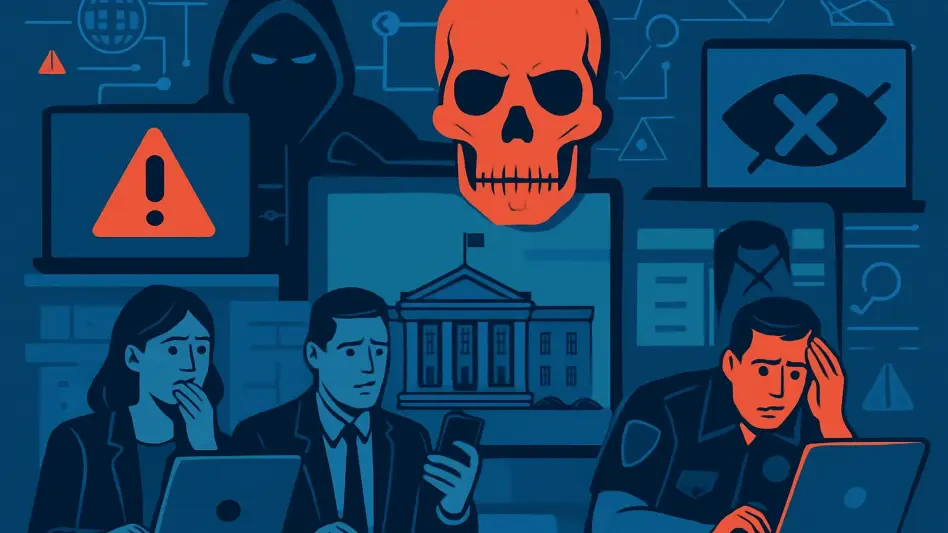In an era where digital threats loom larger than ever, state and local government agencies across the United States find themselves on the front lines of a relentless cyber battle, often ill-equipped to defend against sophisticated attacks. Recent ransomware incidents, such as those striking Nevada and St. Paul, Minnesota, have laid bare the vulnerability of these smaller entities, disrupting critical services like emergency communications and costing millions in recovery efforts. These events are not mere anomalies but symptoms of a broader, alarming trend where cybercriminals deliberately target under-resourced agencies, knowing their defenses are thin. The situation is compounded by a stark reduction in federal support, leaving local governments scrambling to protect vital infrastructure with limited budgets and expertise. This growing crisis raises pressing questions about the sustainability of public services and the broader implications for national security when the backbone of community operations is at risk.
Escalating Vulnerabilities in Local Systems
Rising Threats to Smaller Jurisdictions
State and local governments have become prime targets for cybercriminals who exploit their constrained resources with ruthless precision. High-profile ransomware attacks, such as the one in Nevada on August 24 and another in St. Paul during July, demonstrate a calculated approach to disrupt smaller agencies, often triggering widespread service interruptions and, in some cases, states of emergency. The impact is profound, with communities facing halted operations and local leaders under immense pressure to resolve crises without adequate tools or funding. These incidents underscore a harsh reality: smaller jurisdictions, tasked with delivering essential services, are seen as soft targets by attackers who bank on their inability to mount a robust defense, making the consequences of each breach not just local but a ripple effect across public trust and safety.
Beyond the immediate chaos, these targeted attacks reveal a deeper systemic issue in how cybersecurity is prioritized at different levels of government. While larger federal agencies and private corporations often have dedicated teams and budgets to counter digital threats, local entities must fend for themselves, piecing together defenses with limited staff and outdated technology. The fallout from such attacks often extends beyond financial loss, eroding public confidence as citizens grapple with disrupted access to vital systems like water management or emergency response. This persistent targeting by cybercriminals, often backed by nation-state actors, signals an urgent need for a reevaluation of how resources are allocated to protect the most vulnerable links in the governmental chain, where the stakes are just as high as at the national level.
Shifting Dynamics of Digital Threats
The landscape of cyber threats facing local agencies is not static but evolving with alarming sophistication, placing unprecedented strain on already stretched resources. Although the volume of ransomware attacks may have leveled off in recent data, the intricacy of these assaults continues to grow, with attackers honing in on zero-day vulnerabilities and critical operational infrastructure such as power grids and water systems. This shift in tactics, noted by industry experts, is designed to maximize disruption, creating scenarios where the immediate impact on public safety forces agencies into considering ransom payments as a desperate measure. The focus on infrastructure reflects a chilling intent to exploit the very systems communities rely on daily, turning digital breaches into real-world emergencies.
Moreover, the increasing cunning of these cyber threats demands a level of preparedness that many local governments simply cannot afford. Attackers are no longer just after data theft but aim to paralyze entire systems, knowing that the ripple effects can cripple a municipality’s ability to function. This evolution requires advanced detection and response mechanisms that are often out of reach for smaller budgets, leaving agencies in a reactive rather than proactive stance. The pressure to restore services quickly often overshadows the need for long-term security investments, perpetuating a cycle of vulnerability. As cybercriminals refine their methods, the gap between the threat level and local capacity to respond widens, highlighting a critical mismatch that must be addressed to safeguard public welfare against these relentless digital adversaries.
Consequences of Diminished Federal Support
Erosion of Essential Cybersecurity Frameworks
The slashing of federal budgets for cybersecurity has dealt a severe blow to local and state agencies, dismantling the critical support systems they once relied upon to bolster their defenses. Significant funding cuts to the Cybersecurity and Infrastructure Security Agency (CISA) and the Multi-State Information Sharing and Analysis Center (MS-ISAC), alongside the elimination of numerous staff positions, have stripped away access to essential threat intelligence, incident response guidance, and basic training programs. This loss is particularly devastating for smaller jurisdictions that lack the internal expertise to navigate complex cyber threats independently. Experts in the field have voiced concerns that such reductions represent a shortsighted policy, undermining national security by leaving the most exposed entities without a lifeline in an increasingly hostile digital environment.
The ripple effects of this diminished federal backing are felt acutely in the day-to-day operations of local governments, where the absence of shared resources exacerbates an already precarious situation. Without the collaborative frameworks provided by agencies like CISA, municipalities struggle to stay ahead of emerging threats or even respond effectively when breaches occur. This gap not only heightens the risk of successful attacks but also slows recovery times, as agencies must seek costly private solutions or patchwork fixes without the benefit of centralized expertise. The erosion of these support structures sends a troubling message: the federal commitment to protecting all levels of government from cyber risks is faltering, leaving local communities to bear the brunt of a national issue with far-reaching consequences for public safety and trust.
Financial and Operational Fallout
The financial rationale behind federal budget cuts in cybersecurity is starkly contradicted by the staggering costs incurred when local agencies fall victim to attacks. The ransomware incident in St. Paul, estimated at a recovery cost of $17 million, stands as a glaring example of how the supposed savings from reductions—such as the $10 million cut to the Center for Internet Security (CIS)—are dwarfed by the expenses of rebuilding after a breach. These costs are not merely monetary; they encompass prolonged service outages, compromised data, and the broader societal impact of disrupted public functions. The disparity between short-term budget trimming and long-term financial burdens illustrates a critical misjudgment in policy, where the price of prevention is far outweighed by the toll of reaction.
This financial strain is compounded by operational challenges that linger long after an attack is mitigated, further exposing the fragility of underfunded local systems. Agencies without federal aid must divert already scarce resources from other critical areas to address cyber incidents, often leading to a cascading effect on community services. The burden of recovery, both in terms of dollars and time, places immense pressure on local leaders to restore normalcy while grappling with the reality that future attacks are likely without systemic change. This cycle of high-cost recovery and inadequate prevention underscores a fundamental flaw in current approaches, where the true expense of diminished federal support manifests not just in balance sheets but in the erosion of public confidence and the stability of essential infrastructure.
Building Resilience Amidst Challenges
Strengthening Local Defenses Independently
In the face of dwindling federal support, local and state agencies are compelled to take ownership of their cybersecurity posture, a daunting yet necessary endeavor given the persistent threat landscape. Investing in basic protective measures—such as regular system patching, immutable backups, and comprehensive employee training—becomes paramount, even when budgets are tight. These fundamental steps, though resource-intensive, can significantly reduce the likelihood of successful attacks and mitigate damage when breaches occur. Experts emphasize that fostering a culture of cyber hygiene within smaller governments is not a luxury but a necessity, as it equips staff to recognize and respond to threats before they escalate into full-blown crises, thereby preserving critical services for communities.
Equally important is the development of contingency plans that allow local agencies to maintain operations during digital disruptions, a strategy that has gained traction among security professionals. Implementing manual processes and conducting regular exercises to simulate worst-case scenarios ensures that essential functions can continue even if systems are compromised. This approach acknowledges the inevitability of attacks in the current environment and prioritizes resilience over mere prevention. For municipalities managing vital infrastructure, such preparedness can mean the difference between a manageable incident and a catastrophic failure, offering a practical path forward while broader systemic issues like federal funding are debated at higher levels of government.
Advocating for Renewed Federal Commitment
While local efforts are crucial, the scale of cyber threats facing state and municipal agencies demands a renewed federal commitment to cybersecurity as a matter of national priority. Advocacy for sustained investment in agencies like CISA and MS-ISAC is gaining momentum among experts who argue that the cost of inaction far exceeds the expense of robust support structures. Restoring funding and staffing to these organizations would reestablish vital resources for threat sharing, training, and incident response, directly benefiting smaller jurisdictions that cannot shoulder these responsibilities alone. This push for federal action is rooted in the recognition that cybersecurity is not a localized concern but a collective challenge with implications for the entire nation’s stability.
Looking back, the response to past budget cuts and their fallout provided a sobering lesson in the interconnectedness of governmental security. The staggering recovery costs and operational disruptions that followed attacks on under-supported agencies highlighted a critical oversight in prioritizing short-term savings over long-term protection. Moving forward, the focus turned to actionable solutions, with calls for policies that ensure sustainable funding for local cybersecurity needs. There was a growing consensus that collaboration between federal and local levels must be strengthened, alongside investments in resilience strategies like manual backups. These steps, initiated in response to earlier crises, aimed to fortify public infrastructure against future digital threats, ensuring that communities were no longer left defenseless in the face of evolving cyber risks.








